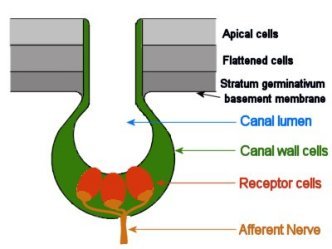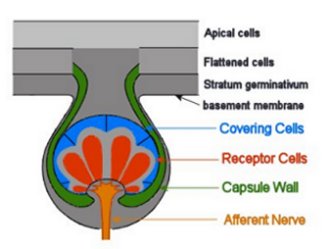
Electroreception is the alternative source of sensory perception
used by electric fish. There are two basic types of cell which can perceive
electrical frequencies, both derived from the lateral line detectors, cells
found in fish for the detection of movement in water. 
Ampullery receptors are found in species of fish outside of the "electric" fish category, such as sharks. These receptors pick up frequencies from 0.2 to 20 Hz. Tuberous receptors pick up much higher frequencies in the range of 30 to 1500 Hz.
Right is an ampulery receptor, which detects the surrounding waters' charge by a neurosignal sent to the brain when a potential difference between the cell and the water is present. The afferent nerve is the motor neuron responsible for the signal.
The latter cell type is subdivided into two further groups, Pulse makers and Burst duration receptors. Pulse makers emit one action potential and code for frequency perception, whereas burst duration receptors emit bursts of action potentials and code for amplitude. Both cell types are triggered by electric signals in the surrounding water and result in a neurotransmitted response, (electric organ discharge, movement etc) just like any other sensory feature such as taste or smell.
Below is a Tuberous receptor, both types of receptor cell are found in the skin of the eel.

Electric fields from other fish are generated regardless of whether or not they are electrogenic. The use of any muscle creates an electric field, so the contractions of a heart could be detected in another fish. The eels can locate objects accurately by measuring frequencies and amplitudes on different parts of the body as well as static electricity, caused by flow of water against the bottom of the river.
By using its own electric organ discharge (EOD) and sensing differences in the current around itself, the eel is able to deduce the conductivity of any surrounding objects, another way of navigation and obstacle detection. In addition, the EOD from other electrogenic fish can be used for communication.
When swimming, the eel minimizes undulating movement by use of its long anal fin, so as to avoid disturbance of its own EOD. It also has the ability to swim backwards.....if scanning potential prey, it will start scanning tail end first and finish with its head at the "right end" of the prey, it will then stun the prey.